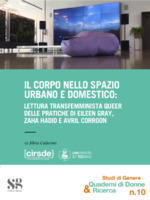Sfoglia documenti (13 in totale)
- Collezione: Studi di Genere. Quaderni di Donne & Ricerca
Sort by:
Intersexuality and the Law: Current European Approaches
This essay focuses on the complex relationship between intersexuality and the law. It aims to highlight the issues that are emerging in European legal systems due to the lack of specific measures or legislation regarding gender identity, and the ad hoc legislation which does exist but fails to distinguish transsexualism from intersexuality.
The most pressing issue that the law should tackle is the performance of unnecessary, irreversible, and invasive surgery on intersex children. Indeed, most of European Member States do not explicitly legally ban this practice.
First, international and European Union law is considered noting that they do not provide for any legally binding instrument for the protection and recognition of intersex human right. However, in recent years they have shown to be progressively responsive towards intersex individuals.
Then, three legislative models are identified and the national legal frameworks corresponding to them analysed. The first, adopted by Germany and Austria, is based on the introduction of a third sex. The second is contained in Belgian legislation, and establishes the self-determination principle, which permits the choice of a preferred gender on identity documents, without particular requirements being met. The third approach has been adopted only by Malta so far. It is characterised by multiple measures and, accordingly, it is more systemic and holistic. In fact, the Maltese legislation explicitly recognises the intersex condition, and it conceives sex as a spectrum, thus going beyond gender binarism. Moreover, it prohibits discrimination based on sex characteristics, establishes the self-determination principle, and it bans irreversible, unnecessary, and aesthetic surgery from being carried out on intersex people.
Lastly, theoretical analysis on the role the law should play in tackling intersex issues is presented. Alongside, some factual cases of human rights violations on intersex people a way forward is proposed, considering the most interesting proposals and insights from the intersex community.
Stereotipi e sessismo linguistico nei manuali di italiano L2/LS: analisi e proposte di riscrittura inclusiva
The work aims at a reconnaissance of the current teaching material used in classes of Italian as a foreign language, bearing in mind the perspective of gender inclusive language and gender stereotypes.
A detailed linguistic analysis of copiuous textbooks – which was carried out upholding the approach of Italian linguist Alma Sabatini - highlights how the female world is still shaped through a male-dominant point of view. As a matter of fact, linguistich inclusivity often fails to be achieved, falling the Italian language into the grammatical gender languages type. The purpose of the analysis present in Chapter 3 is to show how a gender sensitive linguistic approach can be obtained and integrated into foreing language teaching material of Italian language, catering to all six level of the CEFR (Common European Framework of Reference for Languages) through degendering and engendering strategies.
On the other hand, the ambition of shaping multicultural beings across the world calls for the analysis of the socio-cultural aspects representing Italy in the aforementioned textbooks. This analysis (Chapter 4) recognizes five areas in which gender stereotypes, regarding the female sphere, are strongly pervasive and fail to represent the actual nuaces of life and personal identity - childhood, labour, family care, housekeeping, and physical appearence.
Lastly, Chapter 5 argues the outcomes of both the linguistic and socio-culultural analysis, in view of a future improvement of such teaching materials.
Il corpo nello spazio urbano e domestico: lettura transfemminista queer delle pratiche di Eileen Gray, Zaha Hadid e Avril Corroon
This essay aims to carry out, through a queer transfeminist methodology, an analysis of the built environment and architectural spaces, with reference to the work of Eileen Gray, Zaha Hadid and Avril Corroon.
In the introduction, the key terms of the paper will be defined, including transfeminism and queer studies. In summary, transfeminism refers to an intersectional feminist methodology that, in its analysis, considers, in addition to sexism, several axes of oppression, such as racism, classism, ableism, sexual orientation - and embraces the struggles of trans people (Filo Sottile 2020). Queer studies, on the other hand, refers to the study of issues involving gender identity and sexual orientation, questioning both the naturalness of the binary division of gender into male and female, as well as that of sexual orientation (Arfini 2020), demonstrating how gender identities are constructed within a set of behaviours, actions, beliefs, and stereotypes that are repeated through a system called gender performativity (Butler 1999). Queer transfeminism has, among its aims, to unhinge a binary system of power through the intersection of feminist and sexual liberation issues with struggles that relate to classism, racism, and ableism, to create an alliance between all subjectivities different from the norm, to achieve social justice.
The first chapter of this paper questions the role of the body in space, examining various urban and architectural structures. The theme of the heterosexual and ableist matrix as prerequisites for understanding our built environment (Wajcman 1991), i.e., the space that bodies relate to, is explored, illustrating the concept of performativity of gender and deviance introduced by Judith Butler (Butler 1999). The theme of the body in architectural design is addressed (Bianchetti 2020), and we finally focus on the issues of housing rights and dispossession, as well as that of social and housing justice (Butler, Athaniasiou 2019).
The second chapter examines the language of gender, analysing language and its constructive and imaginary potential. The role of gendered language in architecture is also analysed, and proposals are shown that can go beyond the limits that our language imposes.
Furthermore, how the mass media have represented bodies in space is explored, and specifically, the photographic material of Le Corbusier's works (Colomina 1992, 1994) and that of Hugh Hefner's Playboy fashion house (Preciado 2020) are analysed.
In the third, fourth and fifth chapters, the work of three female artists is explored: the work of Eileen Gray is examined, looking in particular at E.1027, the house that the designer-architect realised in France, according to a queer reading of the architectural project; Zaha Hadid's practice is read from a transfeminist perspective, and in particular through Donna Haraway's cyborg myth; the work of Avril Corroon, a contemporary Irish visual artist, is analysed, whose practice questions the housing emergency in the contemporary neoliberal market.



